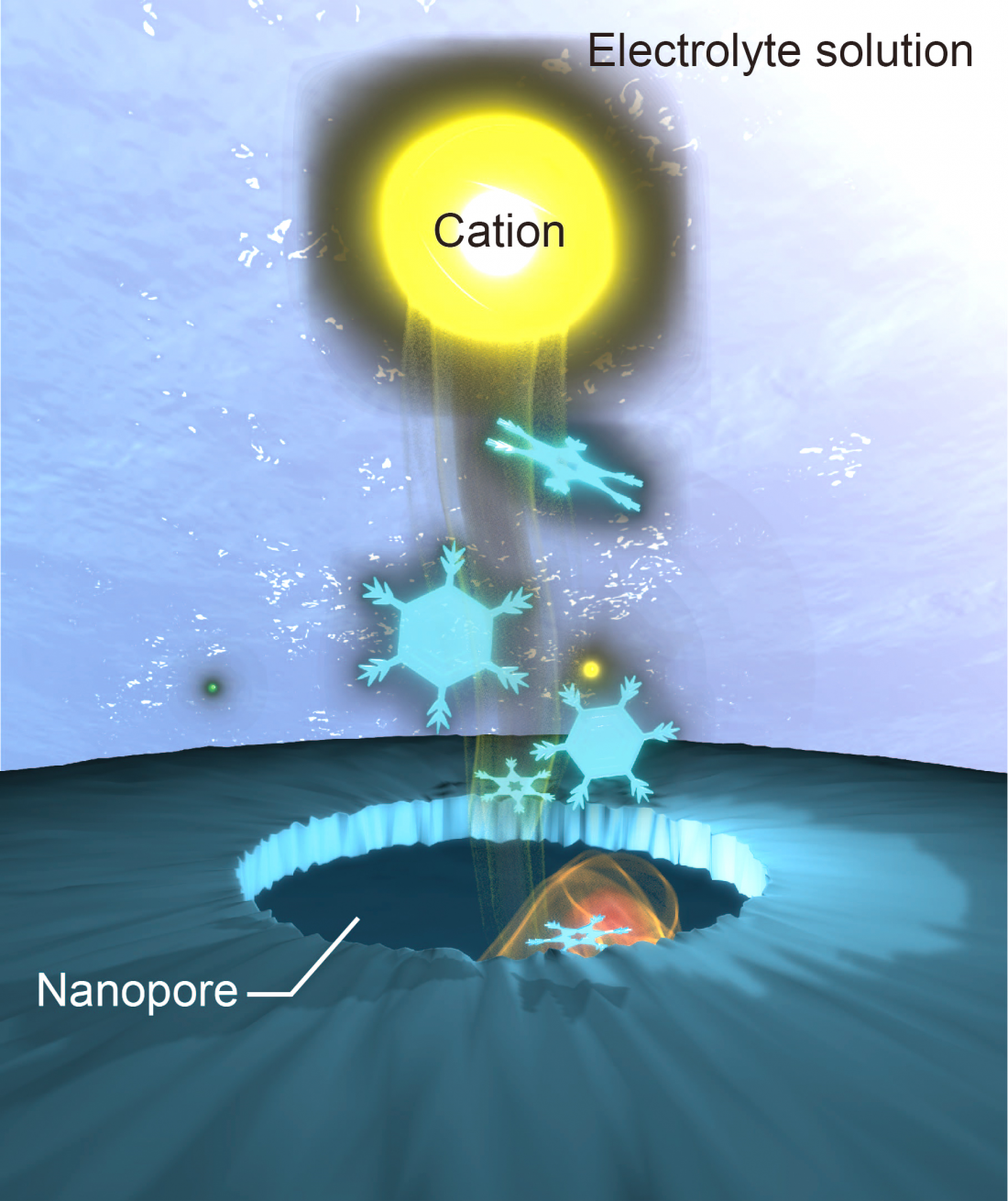Fig. Schematic illustration depicting nanopore cooling by charge-selective ion transport.
Researchers from Osaka University take an in-depth look at cooling effects caused by charge carriers in permselective nanopores
Osaka, Japan – Have you ever wondered how water boils in an electric kettle? Most people may think electricity simply heats up the metal coil inside the kettle, which then transfers the heat to the water. But electricity can do more than that. Heat can be generated when electricity makes ions in solution flow. When all the ions and surrounding molecules can move freely, this heating effect is evened out across the whole solution. Now researchers from Japan have investigated what happens when this flow is blocked in one direction.
In a study recently published in Device,the team led by researchers from SANKEN (The Institute of Scientific and Industrial Research), Osaka University has shown that it is possible to achieve cooling by using a nanopore—a very small hole in a membrane—as a gateway that only allows certain ions through.
In general, using electricity to drive ions in solutions draws positively charged ions and negatively charged ions in opposite directions. So, the heat energy carried by the ions travels both ways.
If the path of the ions is obstructed by a membrane with only a nanopore to get through, then it becomes possible to control the flow. For example, if the pore surface is negatively charged, then the negative ions can interact with it rather than pass through, and only the positive ions will flow, taking their energy with them.
“At high ion concentrations we measured an increase in temperature as the electrical power was increased,” explains study lead author Makusu Tsutsui. “However, at low concentrations the available negative ions interacted with the negatively charged nanopore wall. Therefore, only positively charged ions passed through the nanopore and a decrease in temperature was observed.”
The ionic refrigeration that was demonstrated could be used for cooling in microfluidic systems—setups that are used to move, mix, or investigate very small volumes of liquids. Such systems are important across many disciplines from microelectronics to nanomedicine.
In addition, the findings could help further the understanding of ion channels, which play crucial roles in the finely balanced machinery of cells. Such insight could be key to understanding function and disease, as well as designing treatments.
“We are excited by the breadth of the potential impact of our findings,” says study senior author Tomoji Kawai. “There is considerable scope for the nanopore material to be tailored to tune the cooling. In addition, arrays of nanopores could be created to amplify the effect.”
The list of areas that could be enhanced by the findings is indeed considerable and extends to using a temperature gradient to generate electric potential. This could be applied for temperature sensing or in blue energy harvesting.
###
The article, “Peltier cooling for thermal management in nanofluidic devices,” was published in Device at DOI: https://doi.org/10.1016/j.device.2023.100188
About Osaka University
Osaka University was founded in 1931 as one of the seven imperial universities of Japan and is now one of Japan's leading comprehensive universities with a broad disciplinary spectrum. This strength is coupled with a singular drive for innovation that extends throughout the scientific process, from fundamental research to the creation of applied technology with positive economic impacts. Its commitment to innovation has been recognized in Japan and around the world, being named Japan's most innovative university in 2015 (Reuters 2015 Top 100) and one of the most innovative institutions in the world in 2017 (Innovative Universities and the Nature Index Innovation 2017). Now, Osaka University is leveraging its role as a Designated National University Corporation selected by the Ministry of Education, Culture, Sports, Science and Technology to contribute to innovation for human welfare, sustainable development of society, and social transformation.
Website: https://resou.osaka-u.ac.jp/en



